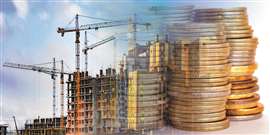What is the status of the North American crane market?
31 May 2023
Three experts discuss market indicators – interest rates, inflation and the possibility of a recession.
Heavy equipment and construction markets are in a unique position. The United States is facing the possibility of a looming recession, while on the flip side, the country is seeing a boom in infrastructure projects following the enactment of President Biden’s Bipartisan Infrastructure Law. With money to spend in the new and used equipment realm, the industry is faced with economic risks and rewards, on both sides of the coin.

ACT reached out to three finance experts to learn more about their thoughts and perspectives on the current market, interest rates, inflation and much more. Panelists for our forum include Jeff Whitcomb, construction industry lead, First Financial Equipment Leasing; Tonya Fry, an owner and vice president, Harry Fry & Associates; and Jay Buechler, senior account manager of construction finance, DLL.
According to the consultant firm Off-Highway Research, North America was the best performing of the major construction equipment markets last year. How do you characterize the market for new and used cranes?
WHITCOMB: We don’t see it slowing in 2023 or 2024. While it may be that personal consumption drags down GDP, we see both private domestic investment as well as government domestic investment continued strength, and for that reason, we see continued strength in the new and used crane market.
FRY: I would currently characterize the market as cautious. I am continuing to hear from my customers that they have more work than they can service. We are constantly barraged with news of a possible recession, continued record high inflation and interest rate hikes, plus international issues. When this is combined with lack of supply of equipment and delivery delays, of course customers are going to be cautious.
However, I find that many customers are trying not to pay attention to the news, but instead considering what is happening in their geographic market. If they have demand for work or are awarded jobs, they are willing to make the crane purchase as they don’t want to lose the work/jobs. As far as new and used cranes go, if customers are in need of equipment, they will purchase what they can get their hands on. As a result, we have definitely seen prices of equipment significantly increase. I do feel if you are in a market to sell, and have quality, used equipment, you are in a good position.
BUECHLER: Despite the potential for a recession in late 2023, the market remains robust in North America for both new and used cranes, as significant project work continues to require cranes to complete these projects. The supply chain disruptions of the last several years has led to a restricted supply of new cranes, with many new crane models not being available until well into 2024. This has led to a very competitive and aggressive market for used cranes, resulting in increased used crane pricing.
 Panelists for our forum include (from left to right) Jeff Whitcomb, construction industry lead, First Financial Equipment Leasing; Tonya Fry, an owner and vice president, Harry Fry & Associates; and Jay Buechler, senior account manager of construction finance, DLL.
Panelists for our forum include (from left to right) Jeff Whitcomb, construction industry lead, First Financial Equipment Leasing; Tonya Fry, an owner and vice president, Harry Fry & Associates; and Jay Buechler, senior account manager of construction finance, DLL.
Economists are predicting a recession in 2023. How Do you anticipate this will impact the sales of new and used cranes?
WHITCOMB: We do not think that the recession will have much of an impact on crane sales, both new and used. We think that it will be a consumer recession, and that the commercial activity that has been planned for all this infrastructure work will be in full swing, and that is going to drive strong demand for 2023 to 2025.
FRY: I feel like economists have been predicting a recession since 2021. In addition, the economists have had contradicting opinions on a recession for the past year. As noted above, I think people are trying to pay attention to what is going on in their market area rather than listen to the news. There is still a demand for quality equipment, and I think it is the lack of inventory that is slowing sales.
BUECHLER: Given the short supply of new cranes and equipment and long lead times on some models, we anticipate that new crane sales, as well as used crane sales, will remain brisk and aggressively priced.
To try to control inflation, the Fed has continually raised interest rates over the past year. How have higher interest rates impacted crane financing?
WHITCOMB: Well, 5 percent may be the target Fed funds rate, but we see actual real interest rates much higher. This was somewhat offset by lending at the regional bank level where deposits sometimes hold down interest rates. With the recent banking crisis, we’ve seen a massive pullback by small and regional banks, as depositors have fled those banks. Unfortunately for the retail marketplace, it seems that the big will get bigger and the small will continue to fight to survive.
FRY: When the Fed initially began raising rates, I think it was sticker shock for many. For almost a decade, we had prime rates at historic lows. Customers were used to rates in the threes and sometimes twos.
When I began my career in crane financing in 2004, interest rates were in the 7 to 8 percent range, and this was the normal range. When my parents started the company in the 1990s, rates were 10.5 to 12 percent. We often say that a business that started within the past ten years doesn’t know anything other than extremely low rates. It seems that these businesses were more affected/surprised by the cost of financing than the older, established companies. It has taken a bit for customers to understand, but due to the lack of supply, if they needed the equipment, they accepted what the interest rate would be. By Q4 2022, the sticker shock had worn off and most understood that these rates were here to stay. I think it helped our company had a strong fourth quarter in 2022 because customers didn’t want to risk rates going up, so they would make the purchase. We understand higher rates are a real money cost to a business but not acquiring equipment because the rates are high impacts the business even more by lost revenues. The decision to acquire equipment is always difficult but is typically made for future long-term benefits.
BUECHLER: Increased interest rates are combining with rising new and used crane prices to drive up financing payments for entities seeking to finance their crane acquisitions. This is causing crane customers to look long and hard at the economics between where their financing payments are going and what crane rental rates they are able to extract from the market. If the economics no longer makes sense, we would not be surprised to see some crane rental companies back away from new equipment purchases.
On the flip side, new infrastructure projects are coming online with federal and local monies being pumped into the market. Does this mean new cranes and related equipment will be needed?
WHITCOMB: Absolutely, yes.
FRY: Equipment will definitely be needed, but as is the common theme, the lack of supply is having quite an impact on this. Companies may pay a premium on available equipment as they would not want to risk losing a job.
BUECHLER: New infrastructure projects will definitely continue to require crane utilization. The crane rental companies that will be best positioned for gaining work on these projects will be those that currently have a large installed base of cranes available to work on these projects, such that they are not reliant on the availability of new equipment to service their project work.
What are the biggest challenges/issues in financing equipment in today’s market?
WHITCOMB: 2024 will be the biggest year of federal disbursements on record for capital investment. For this reason, we see continued strength and continued demand for crane and lift equipment.
FRY: I think the biggest challenge in financing right now is that credit is beginning to tighten a bit. Lenders are still lending and buying deals. However, we are finding that they are asking more questions. They want more details on why the equipment is needed and projections for additional work in 2023 and beyond. Lenders are definitely still buying deals. With the constant threat of a recession, they are digging a little deeper into deals, and the credit box is just a bit tighter. I would say that customers just need to be patient when asked for additional info.
BUECHLER: The biggest challenge we see currently in the crane financing market, with increased crane prices and increased interest rates already mentioned, is trying to provide a financial solution that results in a payment that makes economic sense for the customer given the rental rates they are able to charge in the market.
STAY CONNECTED


Receive the information you need when you need it through our world-leading magazines, newsletters and daily briefings.




